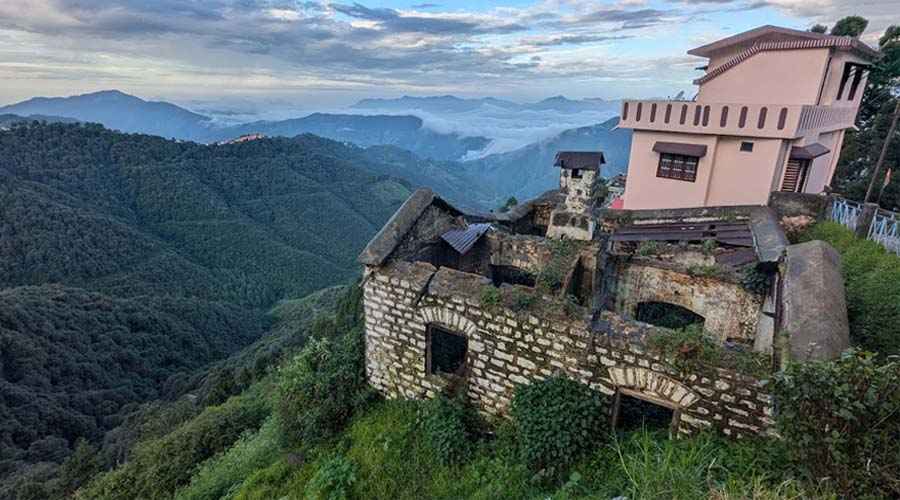Nestled near Dobbaspet in Bengaluru Rural district of Karnataka, Shivagange Hills is a majestic mountain peak rising to a height of approximately 1,368 meters (4,488 feet). Known for its unique natural formation shaped like a Shivalinga and a perennial spring locally called “Ganga,” this sacred hill has long been revered as a significant Hindu pilgrimage center as well as a notable historical site. Often referred to as Dakshina Kashi, or the Kashi of the South, Shivagange holds an extraordinary blend of spirituality, mythology, history, and natural beauty that attracts devotees, trekkers, and history enthusiasts alike.
Spiritual and Religious Significance
Shivagange’s spiritual importance is deeply rooted in Hindu mythology and religious traditions. The name itself derives from the shape of the peak resembling a Shivalinga — a symbolic representation of Lord Shiva — along with the presence of the “Ganga” spring that is believed to have divine origins. It is said that from different viewpoints, the hill appears in various divine forms: from the east as a bull, from the west as Lord Ganesha, from the north as a serpent, and from the south as the Shivalinga itself. This multiplicity of divine shapes enhances its sacred aura and mystical appeal.
The hill is home to several important temples and sacred spots including the Gangadhareshwara Temple, Sri Honnammadevi Temple, and the Patalaganga Sharadambe Temple along with various natural water bodies called theerthas like Agasthya Theertha, Kanva Theertha, Kapila Theertha, and Olakal Theertha. The Gangadhareshwara Temple, carved inside a cave, is particularly famous for a unique ritual where the ghee used for abhisheka (anointing the Shivalinga) reportedly turns into butter, believed by devotees to possess medicinal properties. A month-long cattle fair is held here every Sankranti, emphasizing its continued cultural and religious significance.
Historical Legacy
Historically, Shivagange has witnessed the patronage of various dynasties, most notably the Gangas and the Hoysalas. During the Hoysala period, it was an important Jain pilgrimage site. An inscription dated 1131 CE at the nearby Chandragiri Hill in Shravanabelagola records the ritual of Sallekhana (ritual fasting unto death) performed here by Queen Shantala Devi, wife of King Vishnuvardhana, marking it as a place of great historical and religious importance. The queen’s connection to Shivagange adds a layer of poignant history, as her death is believed to be linked with both religious devotion and political circumstances of that era.
The presence of Hoysala architectural features, such as the pillars in the Gangadhareshwara cave temple and Vijayanagara style gateways with rock-cut mantapas on the hill, attest to the area’s historical depth. The temple structures and fortifications were expanded and maintained over several centuries by rulers including Shivappa Nayaka and Magadi Kempegowda, founder of Bengaluru, who also reputedly stored part of his treasure here. Various inscriptions found on temple bells and stones commemorate contributions by royal families such as the Yelahanka Nadaphrabhu lineage, who were staunch Shaivaites and supporters of the site’s religious heritage.
Trekking and Nature Experience
Beyond its spiritual and historical dimensions, Shivagange has also become a popular trekking destination due to its accessible yet adventurous trails. The trek up to the summit covers about 6 kilometers through a well-marked path that includes human-made steps carved out of the rocky terrain. The climb becomes steeper and narrower near the summit, where safety rails have been installed to assist visitors. Along the trail, trekkers can find small stalls selling refreshments, making the journey manageable even for beginners. The hill is inhabited by monkeys and various native flora and fauna, adding to the natural charm of the hike.
The panoramic views from the top are rewarding, offering sweeping vistas of the surrounding landscape, including glimpses of Bengaluru city and Tumakuru region. The ascent itself is considered a pilgrimage experience in its own right, believed to be spiritually equivalent to a visit to Benares (Varanasi), one of Hinduism’s holiest cities. This unique blend of physical exertion and spiritual fulfillment draws both devotees and adventure seekers throughout the year.
Cultural Events and Practices
The annual Sankranti festival at Shivagange is a highlight for pilgrims and locals. During this time, the marriage ritual of Sri Gangadhareshwara (Lord Shiva) and Sri Honnammadevi (Parvati) is symbolically conducted, accompanied by the appearance of sacred water that oozes naturally from the rock at the hill’s peak. It is a time of great religious fervor, drawing thousands of devotees who come to witness and partake in the celebrations. The site’s association with such long-standing traditions reinforces its position as a vibrant spiritual and cultural hub.
Environmental and Conservation Aspects
Shivagange is not only a heritage site but also an ecological treasure. The river Kumudvathi, a tributary of river Arkavati, originates here and supports numerous villages downstream. However, environmental challenges like deforestation, soil erosion, and groundwater depletion have threatened the river and local ecosystems. Conservation projects aimed at restoring water flow and safeguarding the unique biodiversity of the region are in progress, highlighting the need to balance pilgrimage and tourism with ecological sustainability.
How to Reach
Shivagange is located approximately 55 kilometers from Kempegowda International Airport (Bengaluru), with the nearest railway stations being Bangalore City and Yesvantpur, about 40 kilometers away. Well-connected by road, regular KSRTC buses and taxis are available, making access relatively easy for visitors from Bengaluru and surrounding areas. The hill is about 7 kilometers off the Bangalore-Tumakuru National Highway (NH 48).
In Conclusion, Shivagange Hills uniquely blend deep spirituality, rich historical traditions, and natural beauty. It remains a sacred pilgrimage site while also offering an exciting trekking experience. Whether seeking religious solace, historical insight, or an outdoor adventure, visitors to Shivagange find a monumental hill that embodies centuries of faith, culture, and heritage in southern India.

